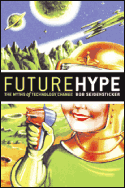Future Hype: The Myths of Technology Change
By Bob Seidensticker
BERRETT-KOEHLER, APRIL 2006
272 PAGES, $15.95
Everyone knows we live in an age of unparalleled technology change that is revolutionizing the way we live, work and play. Everyone is wrong.
So argues Bob Seidensticker, a veteran of IBM and Microsoft, who now writes both software and books. In methodical fashion he sets out to disprove such conventional wisdom as:
Change is exponential. If it were, wouldn’t we now travel in airplanes that fly at Mach 6 and work in skyscrapers that really scrape the sky?
Important new products are arriving at an ever-increasing pace. It’s true the number of new products is steadily increasing, yet most are just line extensions. “The per capita rate of patent introduction may actually be dropping.”
Products catch on faster. They don’t. Radio, television, the personal computer and the Internet, Seidensticker writes, all “took similar amounts of time to mature.”
The Internet changes everything. As all the failed dot-coms learned the hard way, it didn’t.
Seidensticker is endlessly entertaining: “In perhaps the ultimate irony of vanishing digital data, we’ve already lost much of the history of the World Wide Web. Many early Web sites have disappeared like extinct species.”
But he also has a larger point. If you buy into all the hype about technology and the rapid pace of technological change, you are bound to make poor decisions about what new products to buy or develop. “A doctor who incorrectly diagnoses a disease won’t prescribe the right treatment. Similarly, we must correctly perceive technology’s impact to deal with that impact correctly.”
One way to gain the necessary perspective is to slow down. “Avoid technological infatuation,” Seidensticker writes. “Cautiously adopt new products, remembering the many failed promises.” Odds are neither you nor your company are going to be left hopelessly behind if you wait to evaluate seriously whether the next big thing truly is.
If you take this mature approach you will be in the minority, and that can only be a good thing, according to Seidensticker. “The hype will continue,” he writes. “Flawed predictions and unjustified euphoria will be common. High-flying tech companies, vetted by well-known and credentialed people, will crash. Claims that paradigms are being broken (‘This is unprecedented!’) and fundamental axioms must be discarded (‘All we need is eyeballs—the money will follow!’) persist.” So be skeptical. “Change does indeed happen,” he concludes. “But the most extreme predictions are the least accurate, and tomorrow will look more like today than most predictions expect.”
Seidensticker’s takeaway message: The people and companies that are going to be the most surprised by technology are the very ones that predicted how fast things would change.
